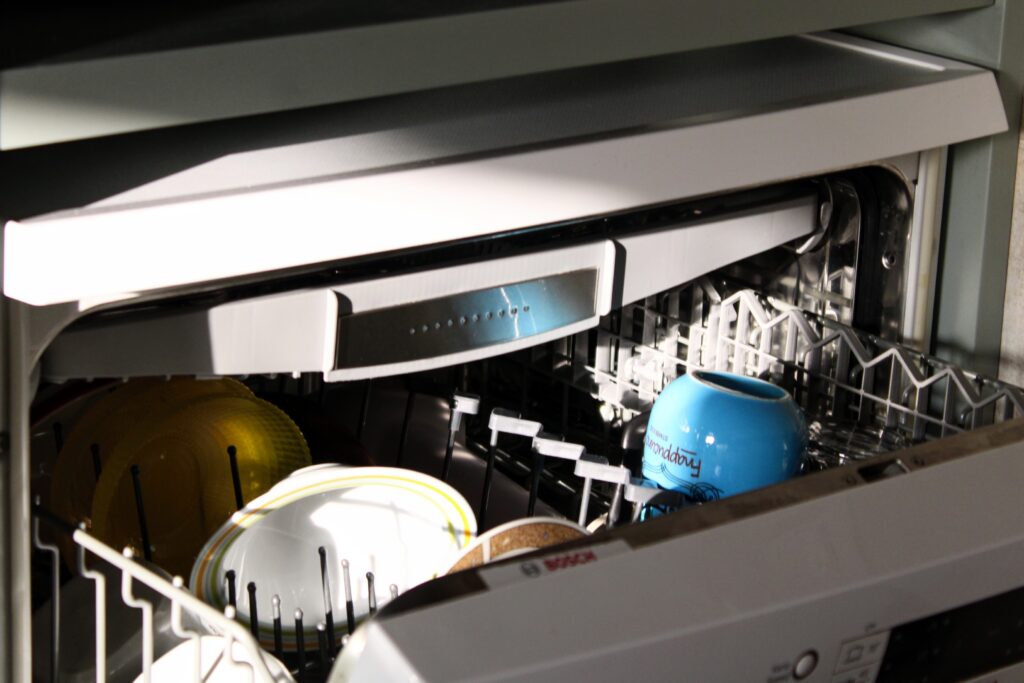Have you ever wondered why your appliances keep malfunctioning? It’s annoying if your home’s appliances don’t seem to last very long and require frequent repair. Dishwashers are an often neglected item that requires cleaning every six months. We need to maintain all of our appliances, not just the dishwashers.

When To Clean Your Dishwasher
Make sure your dishes are clean by cleaning your dishwasher once a month to keep the machine functioning efficiently and avoid the growth of germs. Put distilled white vinegar in a dishwasher-safe cup (I often use a two-cup Pyrex measuring cup) and set it upright on the top rack of a full dishwasher.
Use the hot-water setting and complete the cycle. After that, deodorize the appliance by pouring a cup of baking soda into the tub and running the dishwasher for half a cycle while using hot water. After that, let your dishwasher air out for a few hours by leaving it open.
Dishwasher Cleaning Instructions
The following step-by-step instructions will show you how to thoroughly clean a dishwasher using vinegar and baking soda. The difference will astound you. Your machine will have a brand-new appearance and operate more effectively than before.
1. Compile your materials
Get your cleaning supplies gathered.
- Warm water
- White vinegar for distillation
- Baking soda
- Rubber gloves
- Toothbrush
- Microfiber cloth
- Toothpick
2. Take out the dishwashing racks, filter, and utensil holders.
The racks, utensil holders, and filter must be taken out so that you can reach the tiny cracks and crevices (some filters simply twist off, but others will require tools to unscrew them). Take them out and submerge them in a solution of 1 cup of white distilled vinegar and warm water. For at least 30 minutes, let them soak.
3. Eliminate all trash.
Once you can see clearly again, look inside for any remaining debris that might be there. Clean the side walls, spray arms, and corners at the top and bottom of the side walls. Look inside all the teeny, tiny holes and slots where water pours out of the dishwasher, the filter, and the dispenser. Use a toothbrush and/or toothpick to remove any food particles or other debris that may have become stuck in such small spaces.
4. Run a hot water cycle with vinegar in the dishwasher.
1 cup of white vinegar should be put in a dishwasher-safe bowl, which should be put on the bottom of an empty dishwasher. The hot water cycle should be selected for the dishwasher. Any traces of food, grease, soap scum, residue, or other lingering filth will be destroyed by the vinegar.
5. Perform one more brief washing cycle with baking soda.
After the first cycle has finished, take out the bowl and coat the dishwasher’s bottom with 1 cup of baking soda. Run a brief cycle with it. The baking soda will clean the dishwasher and eliminate odors. As a result? A dishwasher that is clean as a whistle and looks fantastic.
6. Wipe the dishwasher’s outside door
Inspect the surface of your dishwasher using a cleaning designed for it: Look for a cleaning product designed for stainless steel, for example, if it’s constructed of stainless steel (all-purpose cleaners can leave a streaky finish or even scratch steel, so be careful).
Another approach? Make your own cleaner. All dishwasher surfaces may be cleaned using an excellent DIY cleanser created from a simple solution of dish soap, water, and white vinegar. Swipe in the grain of the surface after dipping a microfiber cloth in the soapy water and wringing away the excess.
For a shiny, fingerprint-free finish, rinse your cloth first and then go over the surface again. Make sure to use your moist cloth to clean the control panel and handles as well.
Why Clean Your Dishwasher
There are several advantages to having knowledge of dishwasher maintenance. You’ll notice that the machine is not only more attractive and pleasant to the eye but also more efficient. You’ll have cleaner dishes because the gadget can now be fully used with soap and water spraying through it at full intensity.
In fact, if your dishes begin to have muck remaining on them after being washed in the dishwasher, your dishwasher likely needs a deep clean. Learn how to correctly load a dishwasher so that you can maintain cleanliness between deep cleanings, and try to do so once every six months to keep your dishwasher functioning at its best.
If your dishwasher includes a self-cleaning sanitizing cycle, you ought to use it once a month in addition to that six-month thorough clean. The sanitizing cycle kills 99.9% of the germs and food dirt that a conventional wash cycle leaves behind by operating hotter and for longer.
You can have Affresh on hand if your dishwasher lacks a sanitizing cycle. The foamy tablet Affresh is intended to be used with a normal full cycle and works to remove residue and dishwashing detergent buildup.
Temperature Settings On Your Dishwasher
We have one more suggestion to make sure your dishwasher is operating at its best: 120°–150°F should be the chosen range. It is not hot enough to clean dishes successfully if the water is not at least 120 degrees. Use the sink closest to the dishwasher and fill a cup with the warmest tap water you can find to check your body temperature. Use a thermometer to measure the temperature inside. You must adjust your water heater if the temperature falls below 120° or rises above 150°.

